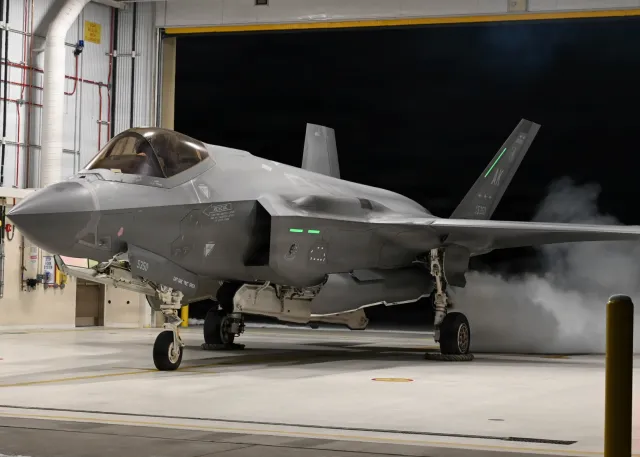Alaska
Arrival of new international cargo carriers in Anchorage celebrated by state officials • Alaska Beacon
Five additional air cargo companies have started operating this year at the Ted Stevens Anchorage International Airport, boosting an important sector of the economy in the state’s largest city, state officials said on Thursday.
The five new operators, all of them international, boost the number of cargo carriers to 39, according to the Department of Transportation and Public Facilities. Thirty-one, including the new arrivals, are international carriers, while eight are regional carriers, according to the department.
The companies newly operating in Anchorage are Awesome Cargo, based in Mexico; Central Airlines of China; ASL Air Cargo, a Belgian carrier; Aerologic Air Cargo, a German company; and CMA CGM Air Cargo, which is based in France.
Ryan Anderson, commissioner of the Alaska Department of Transportation and Public Facilities, said the new arrivals show how the cargo business is growing in Anchorage, with the state’s help.
“We’re really focused on expanding our capacity for cargo,” he said at a news conference held at the Anchorage airport’s fire station. To that end, the department has created an interdisciplinary cargo team that is planning the changes needed to accommodate increased cargo traffic, he said.
Those plans include physical expansion of taxiways as well as modernization of energy use, such as the integration of solar energy and other renewable sources, Anderson said.
The Anchorage airport, with its strategic position between continents, has long been one of the world’s busiest for cargo traffic. For a while in 2020, at the early part of the COVID-19 pandemic, it was the top cargo airport, though it has generally been in the second spot nationally – after Memphis, the headquarters of FedEx – and in the top five internationally.
As of 2023, Anchorage ranked fourth in the world in the amount of cargo shipped, according to Airports Council International (ACI) World, an aviation industry organization.
While cargo volume slipped a bit between 2022 and 2023, it has since increased, according to state officials. Cargo volume passing through the Anchorage airport increased 4.9% from fiscal 2023 to fiscal 2024, according to the department. Alaska’s fiscal year runs from July 1 to June 30, so fiscal 2024 ended in the middle of summer.
Volume through the airport is expected to grow by another 2% this fiscal year, reaching what is anticipated to be a record 149.5 million pounds, according to the department.
Also underway at the Anchorage airport, as with all other state-operated airports, is a transition to firefighting foams that are free of per- and polyfluoroalkyl substances, or PFAS chemicals. Linked to numerous health problems such as cancer and reproductive problems, PFAS compounds are commonly called “forever chemicals” because they are extremely persistent in the environment and in bodies of people and animals. In Alaska, as in most of the nation, the biggest source of PFAS contamination in the environment is from firefighting foams, largely those used at airports and at military sites.
A newly enacted law in Alaska requires airport fire departments to switch to non-PFAS foams by Jan. 1.
At the Anchorage airport, officials said they are striving to meet that deadline.
“It’s something we’ve been diligently working on since the legislation passed,” said Aaron Danielson, the police and fire chief at the Ted Stevens Anchorage International Airport.
Companies that sell non-PFAS foams have already been identified, thanks in part to the military branches that have already started switching out their foams, he said. There are now four vendors offering to sell safer foams to the state, so no supply problems are expected, he said.
The challenge will be getting all the firefighting trucks and equipment properly cleaned so that the non-PFAS foams can be used, Danielson said.
Qualified cleaners to handle PFAS-contaminated equipment are few, and they will be needed at all state-operated airports, not just Anchorage, he said. “It’ll be a process for all of us, and it’ll get phased through, to get the cleaners coming through to one department, to another department and continue moving on,” he said.
Anderson said the department has the money for the switchover in this year’s budget and that the deadline is in sight.
“We expect that this winter we will have this equipment clean, and we’ll be fully functional with the new foams,” he said. “It’s a high priority for us.”
YOU MAKE OUR WORK POSSIBLE.

Alaska
Trump Repeals Biden Land Protections in Alaska, Other States

Alaska
Alaska Hosts US Bomber Exercise Against ‘Threats to the Homeland’

The United States deployed two bombers to simulate strikes against “maritime threats” to the homeland in response to a growing Russian and Chinese presence near Alaska.
Newsweek has contacted China’s Foreign Ministry for comment by email. Russia’s defense and foreign ministries did not immediately respond to a request for comment.
Why It Matters
Russia and China have closely cooperated in military matters under their “partnership without limits,” including a joint naval maneuver in the north Pacific near Alaska’s Aleutian Islands involving 11 Russian and Chinese vessels in summer 2023.
Facing a growing Moscow-Beijing military partnership, along with increased Chinese activities in the Arctic, the U.S. has been reinforcing its military presence in Alaska by deploying warships and conducting war games with its northern neighbor, Canada.
Bombers, capable of flying long distances and carrying large amounts of armaments, are a key instrument for the U.S. military to signal its strength. The American bomber force has recently conducted operations as a show of force aimed at Russia and China.
What To Know
According to a news release, the Alaskan Command executed simulated joint maritime strikes with Air Force B-52H bombers and the Coast Guard national security cutter USCGC Kimball in the Gulf of Alaska on Tuesday as part of Operation Tundra Merlin.
The bombers are assigned to the 2nd Bomb Wing out of Barksdale Air Force Base in Louisiana, while the Kimball is homeported in Honolulu. The 354th Fighter Wing at Eielson Air Force Base in Alaska also deployed four F-35A stealth fighters.
Other supporting units included two KC-135 aerial refueling aircraft and an HC-130 aircraft on standby to conduct personnel recovery missions, the news release said.
During the operation, the bombers received target information from the Kimball for standoff target acquisition and simulated weapons use, while the F-35A jets—tasked with escorting the bombers—enhanced mission security and operational effectiveness.
According to an Air Force fact sheet, each B-52H bomber has a maximum payload of 70,000 pounds and is capable of carrying up to 20 standoff weapons—designed to be fired from outside enemy defenses—such as the Joint Air-to-Surface Standoff Missile.
The simulated strikes “demonstrated the capability of the [U.S. Northern Command] and its mission partners to deter maritime threats to the homeland,” the news release said.
Homeland defense is the Alaskan Command’s top priority, said its commander, U.S. Air Force Lieutenant General Robert Davis, adding that the ability to integrate with other commands and partners is key to safeguarding the U.S. northern approaches.

What People Are Saying
U.S. Air Force Lieutenant General Robert Davis, the commander of the Alaskan Command, said: “Operations in the Alaskan Theater of Operations are critically important to North American Homeland Defense. Operation Tundra Merlin demonstrates the Joint Force’s ability to seamlessly integrate capabilities from multiple combatant commands and mission partners to deter and defeat potential threats in the region.”
The Alaskan Command said: “Operation Tundra Merlin is a Homeland Defense focused joint operation designed to ensure the defense of U.S. territory and waters within the Alaskan Theater of Operations (AKTO). The operation includes integration with partners in the region with the shared goal of North American defense in the Western Arctic.”
What Happens Next
It remains to be seen whether Russia and China will conduct another joint air patrol near Alaska following a similar operation over the western Pacific earlier this week.
Alaska
Dunleavy says he plans to roll out fiscal plan ahead of Alaska lawmakers’ return to Juneau

Gov. Mike Dunleavy says he will roll out a new plan to stabilize Alaska’s tumultuous state finances in the coming weeks ahead of next month’s legislative session. The upcoming session provides Dunleavy his last chance to address an issue that has vexed his seven years in office.
“(The) next three, four, five years are going to be tough,” Dunleavy told reporters Tuesday ahead of his annual holiday open house. “We’re going to have to make some tough decisions, and that’s why we will roll out, in a fiscal plan, solutions for the next five years.”
The state’s fiscal issues are structural. Since oil prices collapsed in the mid-2010s, Alaska has spent more money than it has taken in despite years of aggressive cost-cutting and a 2018 move to tap Permanent Fund earnings to fund state services.
Dunleavy said a boom in oil and gas drilling and growing interest in a natural gas pipeline from the North Slope to an export terminal will likely ease the fiscal pressure in the coming years. He said his plan would serve as a bridge.
“I think the next five years, we’re going to have to be real careful, and we’re going to have to have in place things that will pay for government,” he said.
Dunleavy, a Republican, declined to reveal even the broad strokes of his plan, saying he plans to hold news conferences in the coming weeks to discuss it.
Prior efforts by Dunleavy and the Legislature to come to an agreement on a long-term fiscal plan have failed.
Dunleavy’s early plans for deep cuts led to an effort to recall him. He has also backed attempts to cap state spending and constitutionalize the Permanent Fund dividend.
A prior Dunleavy revenue commissioner floated a few tax proposals during talks with a legislative committee in 2021, but Dunleavy has since distanced himself from those ideas. Alaska is the only state with no state-level sales or income tax, and asked directly whether his plan would include a sales tax, he declined to say.
“You’re just going to have to just wait a couple more weeks, and we’ll have that entire fiscal plan laid out, so you guys can take a look at it, and the people of Alaska can take a look at it,” he said.
In recent years, Dunleavy has proposed budgets with large deficits that require spending from savings. His most recent budget would have drained about half of the savings in the state’s $3 billion rainy-day fund, the Constitutional Budget Reserve, or CBR.
Still, Dunleavy says he wants to find a sustainable fiscal path forward for the state.
“We are determined to help solve this longstanding issue of, how do you deal with balancing the budget, and not just on the backs of the PFD or the CBR — what other methods are we going to employ to be able to do that?” he said.
Whether lawmakers will be receptive is an open question. Democrat-heavy bipartisan coalitions control both the state House and Senate, and even some minority Republicans crossed over to override Dunleavy’s vetoes repeatedly this year.
Dunleavy’s budget proposal is likely to offer some clues about the governor’s fiscal plan. He has until Dec. 15 to unveil it.
-

 Alaska6 days ago
Alaska6 days agoHowling Mat-Su winds leave thousands without power
-

 Politics1 week ago
Politics1 week agoTrump rips Somali community as federal agents reportedly eye Minnesota enforcement sweep
-
Ohio1 week ago
Who do the Ohio State Buckeyes hire as the next offensive coordinator?
-

 Texas6 days ago
Texas6 days agoTexas Tech football vs BYU live updates, start time, TV channel for Big 12 title
-

 News1 week ago
News1 week agoTrump threatens strikes on any country he claims makes drugs for US
-

 World1 week ago
World1 week agoHonduras election council member accuses colleague of ‘intimidation’
-

 Washington3 days ago
Washington3 days agoLIVE UPDATES: Mudslide, road closures across Western Washington
-

 Iowa5 days ago
Iowa5 days agoMatt Campbell reportedly bringing longtime Iowa State staffer to Penn State as 1st hire

























